Spanning more than a century of change, the book captures key moments in the evolution of Doncaster and Bassetlaw’s hospitals—from early cottage facilities and wartime resilience to the formation of the NHS and the high-tech treatments of today.
Whether you’re a lifelong resident, a history enthusiast, or part of Team DBTH, Good Health offers a fascinating and often moving insight into the people, places, and progress that have shaped care in our communities.
You can read the content below, and see a PDF of the book here.
Foreword
As Chair of the Board and Council of Governors at the Trust, it is with great pride that I present to you this short pictorial story of our long history of providing hospital services in Doncaster, Bassetlaw and surrounding areas. We are privileged that Garry Swann has used his extensive knowledge and access to our archives to bring this picture book into existence, all proceeds from which will be donated to our charity. As you will read, charitable funds have always played a key role in developing services for the local NHS and today those funds allow us to go ‘Above and Beyond’ NHS-funded care to make our patients’ time with us that little bit more comfortable.
On behalf of the entire Trust, I want to thank you for supporting Doncaster and Bassetlaw Teaching Hospitals Charity and wish you good health in the years ahead. Suzy Brain England OBE Chair of the Board Doncaster and Bassetlaw Teaching Hospitals NHS Foundation Trust Doncaster and Bassetlaw Teaching Hospitals NHS Foundation Trust.

2018 – A Year of Anniversaries
2018 is a year of anniversaries for Doncaster Royal Infirmary. One hundred and fifty years ago, on 1 July 1868, the Doncaster General Infirmary and Dispensary in Wood Street opened to receive its first patients. Originally, the hospital provided 23 beds on two floors. Funding was secured entirely from local subscribers.


Fifty years later the town’s population had grown to some 28,000 persons, due largely to the industrial development, particularly railways, that had taken place during that time. The sinking of mineshafts all around Doncaster during the early 1900s created many new villages, swelling the population still further. It was universally agreed that a bigger hospital was needed, but following the Great War of 1914-1918 a long and bitter debate, known as the ‘Battle of the Sites’, took place over where the new hospital should be built. Finally, after considerable pressure from colliery and railway companies, all owned privately at that time, a large tract of land in Thorne Road was 1868 Doncaster General Infirmary and Dispensary Wood Street opens 1890 Montagu Cottage Hospital opens 1902 Kilton Hospital Worksop opens 1923 New Retford Hospital opens 1900 Victoria Hospital Worksop opens 1906 Princess Christian visits Wood Street Infirmary. ‘Royal’ title conferred 1926 Edward, Prince of Wales, lays foundation stone, Thorne Road Infirmary 1887 Retford Cottage Hospital opens settled upon. Building began in 1928, but money rapidly ran out. Funding still relied wholly on local efforts and the precarious state of finances prevented much of the architect’s rather grandiose scheme from being carried out. A much smaller building than that originally envisaged opened in 1930.
The hospital struggled on as best it could during the lean years of the 1930s. When the Second World War broke out in 1939, 200 additional beds were provided in hutted accommodation in the grounds for the reception of war wounded. An extension to the nurses’ home was built to house the additional nurses required to staff the five huts. Towards the end of the war HM Government published its plan for a post-war Welfare State, which included a proposal that the country’s haphazard health service provision be amalgamated under one banner, to be called the National Health Service (NHS), funded through taxation and providing a uniform standard of care throughout the country.
1930 Thorne Road Infirmary opens 1984 Phase I Bassetlaw District General Hospital 2001 Merger with DRI and Bassetlaw 1939 Outbreak of World War II. Hutted wards built at DRI and Bassetlaw 1982 Montagu Hospital amalgamates with DRI 1995 Partnership between DRI and Bassetlaw 2017 Teaching hospital status for DBTH 2018 Anniversary of the NHS and Doncaster Royal Infirmary 1948 Foundation of the NHS Doncaster and Bassetlaw Teaching Hospitals NHS Foundation Trust The NHS came into being on 5 July 1948. Doncaster Area Health Authority was established, encompassing Loversall Hospital, Tickhill Road Hospital, St Catherine’s Hospital and Western Hospital, all in fairly close proximity on the western side of town, together with Conisbrough Hospital and Fullerton Hospital, Denaby, Doncaster Royal Infirmary serving as the hub. Some administrative departments were based at York House, Cleveland Street, in the centre of town. Fortunately, Doncaster Royal Infirmary (so called after Royal patronage was granted in 1906) had been built on a site of substantial size to allow for expansion.
A larger hospital for the town was clearly needed, a proposal having been mooted as early as 1951. It was to be another ten years, however, before building commenced. The concept of district general hospitals, where a comprehensive development providing a full range of services, including maternity and psychiatric care, to a large regional population, was deemed the answer to the country’s needs. Doncaster, with its extensive available site and excellent communications by both road and rail, was chosen as one of the scheme’s pioneers, and Doncaster Royal Infirmary became the country’s first district general hospital to be completed. During the 1960s the building opened in stages: early developments were doctors’ residential accommodation, a nurse teaching unit, and a sorely-needed new chest clinic.
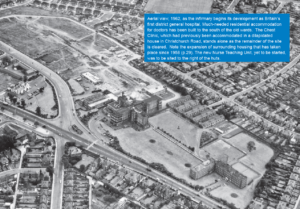
The hospital’s most significant feature was the 390-bed East Ward Block which opened in 1968, as did another important and innovative facility, the Post-Graduate Medical Teaching Centre, which recognised the need for doctors to continually keep up to date with their knowledge and skills. Most of the new building extended along Armthorpe Road, at whose junction with Thorne Road the 1930s building stood. It included a Psychiatric Hospital, Outpatients Department, Maternity Hospital and Operating Theatre Block, together with the many support facilities necessary for such an institution. Also in 1968, the Doncaster Nurse Training School was for the first time given official recognition to confer State Enrolled (SEN) status on nurses who had trained for this qualification entirely in Doncaster (State Registered Nurses (SRN), had been trained in Doncaster since 1924). This 70th Anniversary year of the NHS is also, therefore, an important year of anniversaries for Doncaster Royal Infirmary. This publication has been compiled in recognition of, and as a tribute to, a great local institution which has served the people of Doncaster and district so well throughout its 150-year history and which, it is hoped, will continue to do so for many years to come.
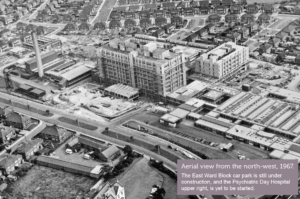
Introduction
It is now 45 years since a history of Doncaster Royal Infirmary was written*. Many changes in healthcare provision have taken place in the intervening years and these are reflected in the numerous additions and modifications to the building that seem now to be a never-ending programme. Administratively too, local healthcare has altered; in 1991 mental health care was transferred to Rotherham Doncaster and South Humber NHS Foundation Trust (RDaSH) and the Psychiatric Hospital on the DRI site re-developed to provide accommodation for other expanding services. At the same time Doncaster merged its acute services with those of Montagu Hospital, nine miles away in Mexborough.
In 1989 HM Government introduced the concept of NHS Trusts, inviting hospitals to apply for Trust status. Two years later Doncaster Royal and Montagu Hospital became one of the first ten authorities to be awarded Trust status. In 1998 Doncaster Royal Infirmary, jointly with Bassetlaw District General Hospital, Worksop, achieved recognition as a Cancer Unit, and two years later the Secretary of State approved full merger of the two authorities, creating Doncaster and Bassetlaw Hospitals NHS Trust. In merging with Bassetlaw Hospital, the Trust also acquired responsibility for Retford and District Hospital, north Nottinghamshire. Foundation Trust status was achieved in 2004.
While for reasons of brevity its name no longer appears in the Trust’s title, Montagu Hospital performs an important role; extensive building work has taken place there, and in addition to offering a wide range of care, the hospital is now the Trust’s main centre for oral health, podiatry and rehabilitation services. Retford Hospital, too, continues to offer an extensive range of services. In 2017 the Trust was granted ‘teaching’ status, linking it with the medical faculty of the University of Sheffield and creating yet another new title, Doncaster and Bassetlaw Teaching Hospitals NHS Foundation Trust.
With an ageing population, increasing demand and an expansion of services, the NHS faces many challenges in the years to come. Nevertheless, Britain’s National Health Service remains the envy of the world, and doubtless Doncaster and Bassetlaw Teaching Hospitals NHS Foundation Trust will continue to play its part in keeping it so. *This book’s sections on Bassetlaw, Montagu and Retford hospitals offer no more than a backward glance at their origins, together with some developments that have taken place since they joined with Doncaster Royal Infirmary to form the present Trust. Their own full histories are yet to be written. Garry Swann The Doncaster Royal Infirmary, 1792-1972. (1973).
Doncaster Royal Infirmary – the early years
Until the eighteenth century, hospital treatment in Britain was largely unavailable. The growth of the population, however, particularly of the poorer classes, and an increasing awareness of their plight when sick, caused doctors and other wealthy citizens to urge the founding of hospitals, and especially dispensaries, where the ‘sick poor’ could obtain treatment. At that time little was known about the causes of disease, and many forms of treatment were ineffectual, sometimes dangerous. Though not the first, Doncaster was one of the earlier towns to establish a dispensary from where its inhabitants could obtain relief from their ills.
At the instigation of a Doncaster surgeon, John Branson, MD, a new charity, the Doncaster Dispensary, was founded in 1792. The Corporation built a house for the purpose in French Gate, on the northern side of town. For the next 60 years the Dispensary continued to treat patients (mainly out-patients, but a bed was provided upstairs for in-patients). During this time industrial activity such as the building of canals and railways made its mark on the town and by 1850 the population had more than doubled. Industry invariably brings accidents, and by the mid-19th century a hospital was badly needed. The nearest hospitals were in Sheffield: the Royal Infirmary, opened in 1795, and the Royal Hospital, built in 1832. In 1853 a local doctor, Dr George Dunn, MD, who practised homoeopathic medicine, had caused his own 8-bed hospital to be erected on St Sepulchre Gate. Though valued by the townsfolk, Dunn’s methods were not approved of by his more conventional professional colleagues, who refused to be associated with his establishment. A solution for the town’s predicament had to be found. In 1862 a bequest of £500 by a former doctor in the town, Henry Bainbridge, MD, was left for the specific purpose of helping to fund a new hospital. This led to the forming of a new charity, the Doncaster General Infirmary, its committee led by the Vicar of Doncaster, the Rev. Dr C J Vaughan. Doncaster Corporation agreed to match Dr Bainbridge’s bequest, and further fundraising efforts enabled the committee to appoint a local firm of architects, Messrs Brundell and Arnold, to draw up plans for the building. A piece of land at the corner of Whitaker Street and Wood Street, close to the town centre, was selected and the foundation stone of the Doncaster General Infirmary and Dispensary was laid on 13 July 1865.
Inside a cavity in the stone was placed a lead box containing numerous items relating to the new building, together with pictures of Queen Victoria and Prince Albert and other eminent persons. No less an authority than Florence Nightingale examined the plans and suggested improvements, which were put into effect. The building was of red local brick, with stonework – again locally sourced – to the front-facing windows, main doorway and decorative features. The hospital was ready for occupancy by December 1866, but lack of funds restricted the number of in-patient beds. The Dispensary was able to move in, however, and did so on 1 May 1867, leaving, no doubt with some joy, their old accommodation in French Gate. At first the two charities, the Doncaster Dispensary and Doncaster General Infirmary, operated independently, but it soon became clear that greater efficiency would result if the two were amalgamated, and this took place in May 1868, thus forming a single charity, Doncaster General Infirmary and Dispensary. The building, offering a total of 23 beds in five wards, opened its doors to the public on 1 July 1868, though it was several months before all the wards could be properly furnished. Within the first three months, 20 in-patients had been treated “…with satisfactory results”. At this time, and for many years thereafter, the charity relied for its funding entirely upon regular subscriptions from the Corporation and the wealthier townspeople, and on fundraising events such as bazaars and local collections.
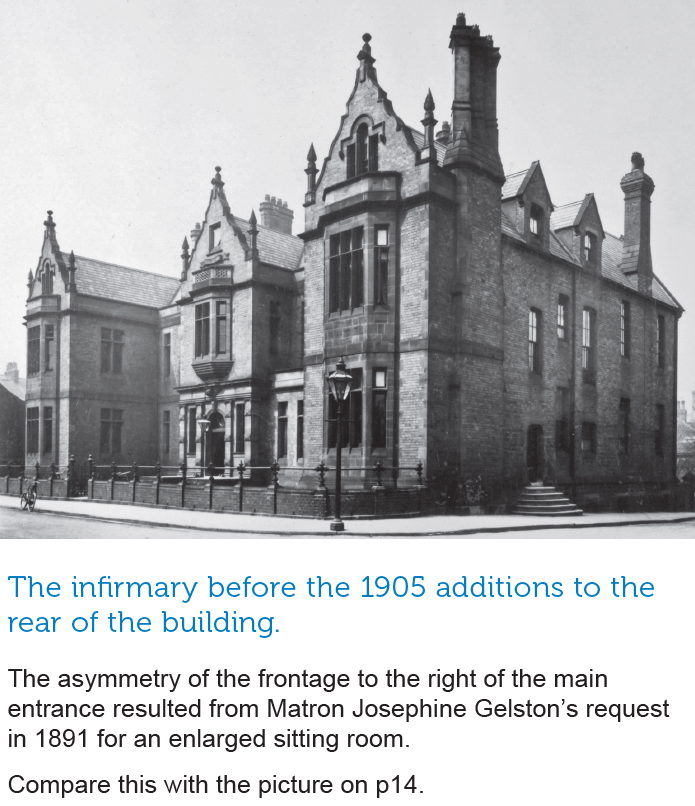
Doncaster’s first nurses were trained and supplied by the Liverpool Training School for Nurses, one of the first such establishments. In 1870 a new arrangement for the supply of nurses was made with the Mildmay Nursing Institution in Stoke Newington, London. In 1896 Florence Longrigg, left, who through Mildmay had been Lady Superintendent at Blandford Cottage Hospital, Dorset, replaced Josephine Gelston as Matron. When in 1899 Mildmay, under new management, withdrew from its contract ‘Sister Florence’, as she was universally known, stayed on as Matron until September 1907.
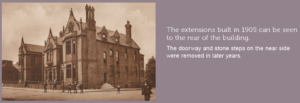

Helena, Queen Victoria’s fifth child, known as Princess Christian after her marriage, was keenly interested in nursing, helping to found the College (later Royal College) of Nursing. In 1906 she visited the Infirmary and opened a bazaar at the Mansion House, held to raise funds to pay for recently-built extensions (see p14). The Infirmary’s Management Committee asked Her Royal Highness if she would agree to become the institution’s Royal Patron. She did so, and subsequently application was made for the hospital in future to be styled ‘Doncaster Royal Infirmary and Dispensary’. The word Dispensary fell into disuse in later years.
The first X-ray photographs to be taken in Doncaster were supplied by Mr T Cuttriss in 1898, using equipment he had built himself. X-ray techniques were employed in both diagnosis and treatment, though the dangers of the radiations used were little understood in early years. Charges for radiotherapy were made according to the means of the patients.
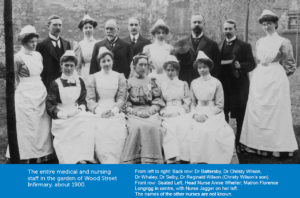
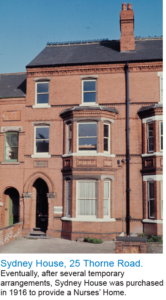
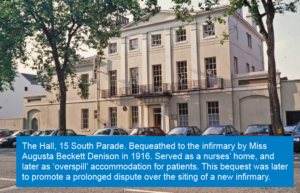
Due to the large number of eye injuries being experienced in the district’s coal industry, local mineworkers in 1925 demanded the immediate establishment of an Eye Department. There being no available space in the Wood Street building, the committee set up a specialist eye department at Springfield House, No.1 Albion Place, South Parade, right. Twelve beds were provided, Dr M. D. Thakore being appointed ophthalmic surgeon. The Hall, 15 South Parade. Bequeathed to the infirmary by Miss Augusta Beckett Denison in 1916. Served as a nurses’ home, and later as ‘overspill’ accommodation for patients. This bequest was later to promote a prolonged dispute over the siting of a new infirmary.
When the Thorne Road infirmary, opened in 1930, was built only inpatient care could be offered. Outpatients were treated at Wood Street for a further five years.
The architect’s scheme for the Thorne Road infirmary, 1925. Building began in 1928, but only a fraction of the scheme was in place before funds dried up. Wards, an operating theatre, administrative offices and a nurses’ home were completed, but an outpatients department was not built until 1935. The new wards were ready for occupation by June 1930; at the end of that month 67 patients were transferred from Wood Street, Springfield House in Bennetthorpe, and The Hall, South Parade.
HRH Edward, Prince of Wales, laid the Thorne Road infirmary’s foundation stone on 12 October 1926. Oddly, the stone was not incorporated into the building until about 1970, when it was placed at ground level in the brickwork of the old ward block, to the right of the Fracture Clinic entrance.
A few weeks later, on Thursday 21 August 1930, Lord Lonsdale officially opened the new building before a large crowd.
For larger contributions, beds could be endowed. £1,000 would endow an adult bed, and £600 a child’s. Here, the Archdeacon of Doncaster dedicates a child’s cot endowed by the Doncaster Women’s Luncheon Club in 1937. Matron Janet Hunter is third from the left. On the right next to the cot is the archdeacon’s wife; beside her is Mrs Phillips, president of the Club and wife of the Editor of the Doncaster Chronicle, who sits next to her. Robert Lancaster, Hospital Secretary (ie the principal administrator), 1936-1946, can just be seen at the extreme right. Numerous beds were endowed, each one furnished with a plaque naming the donor of the endowment; sadly, none of these commemorative plaques has survived.
In 1939 the Ministry of Health caused five huts to be erected to the south of the main building for the reception of war wounded. Intended as temporary accommodation for the duration of the war, they stood for many years afterwards. Local people were generous with their time in visiting war casualties, who were often far from home, and also in providing such additions to their diet as they could afford. Miss Kay Baker, who lived in St. Patrick’s Road behind the infirmary, began a life-long association with the hospital by visiting war casualties, mainly housed in the huts. She is seen here with some of them, together with her parents, who invited forces personnel into their home for meals.
Volunteers filled and stacked 100,000 sandbags around the ground floor walls after war was declared on 3 September 1939. Air-raid shelters were built in the grounds and an observation post was sited on the roof.
The five huts built for the reception of war wounded can clearly be seen. Each was heated by four coal-fired stoves: their scorch-marks can be detected on the asbestos roofs. The extension to the Nurses’ Home, lower right and at right angles to the original home, was built to house the extra nurses required to care for war casualties. The block at upper left is the Outpatients Department, opened in 1935, and between this and the original ward unit is the operating theatre block opened in 1950.
After their operation, hut inmates were wheeled on trolleys along the open-sided walkway visible alongside the south-facing ward block, with a sharp right turn to gain access to the hutted wards. In inclement weather canvas sheets were hung along the open sides of the walkway to protect the patients from the elements.
Note the tiled fireplace and open fire with coal scuttle. The rocking horse no doubt brought patients pleasure but a later, much larger, one was deemed dangerous and put out to grass – a sign of changing times.
The laboratory of 1952 is a far cry from those of today – equipment shown is little more than a simple microscope and a Bunsen burner, with accompanying flasks and test tubes. After 1 January 1931 the hospital provided Doncaster Corporation with a bacteriological service. The Dispensary in 1952, although possessing modern lighting, still contained a multitude of traditional jars and bottles. Pills and other preparations were made up on the premises.
Many organisations were involved in the construction of the new hospital, which took place in the 1960s.
The school was inaugurated in 1925, as work on the new hospital on Thorne Road was begun. Initially, lectures were presented in the Nurses’ Home’s badminton hall (above), practical training being given on the wards. A Preliminary Nurse Training School was founded in 1944, though these students were allowed to live at home. The large number of nurses under instruction made the necessity for better training accommodation more urgent, and a spacious Nurse Training Unit opened in 1966.
Designed by Doncaster School of Art student Edith Hooper, 1930.
Aerial view of DRI site, 1969. The new development is complete. Four of the huts have disappeared, leaving a large car-parking area. Completed in 1969, the Maternity Hospital (now the Women’s and Children’s Hospital) fills the area between the old West Ward Block and the Nurses’ Home, while the Psychiatric Hospital and its Art Therapy unit stand to the rear of the East Ward Block. Psychiatric services were later transferred to another Trust (RDasH) and their former accommodation now houses other departments.
In addition to the well-recognised work of doctors and nurses, many other occupations are involved in hospital care.
Bassetlaw Hospital
The foundation stone for Bassetlaw Hospital, situated on Kilton Hill on the north-eastern side of town, was laid on 1 January 1902. Then known as the Poor Law Infirmary, it was built on land adjacent to the ‘Workhouse’. Hospital care was provided at the five-bed Victoria Hospital in Watson Road, opened
in 1900. A new block was added to the Kilton Infirmary in 1910 to treat phthisis (TB) patients. The administration block was extended and corridor wards added in 1930. As in other towns, including Doncaster, the anticipation in 1939 of large numbers of war wounded caused the Minister of Health to authorise the construction of ‘temporary’ hutted accommodation. With an expected life of 15 years, six huts (five for wards and one for staff accommodation) were built. These huts remained in service until long after the war ended, and were finally demolished in 2002, having been unused by patients for several years.

Following this demolition, major redevelopment took place on the site with the purpose of providing the town with a District General Hospital, the first phase of which was opened on 26 March 1984. In 1988 casualty and inpatient facilities at Retford Hospital, some eight miles distant, were transferred to Bassetlaw District General Hospital, though community and some other services were retained at Retford. Victoria Hospital was demolished in 1996. Trust status was conferred on Bassetlaw in 1992. A formal merger between Bassetlaw and Community Services NHS Trust and Doncaster Royal Infirmary and Montagu Hospital NHS Trust was proposed in 1999, and after public consultation approval for the merger was given. Since then considerable new development has taken place on the Kilton Hill site.
Retford Hospital
The market town of Retford, North Nottinghamshire, established a cottage hospital, annexed to its Dispensary at 40 Chapel Gate, in 1887, in commemoration of Queen Victoria’s Jubilee. Staffed by one resident nurse, it offered three beds and one child’s cot, and was officially opened on 2 January 1888. This small building was soon deemed inadequate and in 1894 the Gylby family offered to the hospital governors at a nominal price a larger house, ‘White Hall’, on
Thrumpton Lane. Whitehall Hospital offered 8 beds and a cot, and opened on 18th October 1894. Due to increasing demand, by 1900 Whitehall needed further modification and an accident ward, children’s ward and operating theatre were provided in a new south wing. A new dispensary was added in 1909. After World War 1 ended a new hospital was built on a site on the Great North Road. The foundation stone was laid by the Duke of Portland on 26 July 1922, and the hospital was officially opened by the Duchess of Portland on 10 August 1923. Whitehall Hospital was then closed. Estimated to cost £10,000 excluding furniture and fittings, funds were raised by public subscriptions and donations, with a contribution from the War Memorial Fund. The hospital contained eight male, eight female and six children’s beds, but had no X-ray equipment. In July 1932 an extension, which included new wards, was opened by Lady Whitaker, whose family had donated an X-ray unit in July 1927.
In 1948 Retford Hospital was absorbed into the NHS; nevertheless, the League of Friends and local benefactors continued their support. In 1975 a major capital scheme provided rationalisation and modernisation of the hospital’s facilities. Some services were transferred to Bassetlaw District General Hospital and thus Retford duly became part of Doncaster and Bassetlaw Teaching Hospitals NHS Foundation Trust.
Montagu Hospital
The growth of the coal mining industry in the Mexborough area prompted the foundation in 1890 of the Montagu Cottage hospital, housed in a former chapel schoolroom in Bank Street. The building was donated for the purpose by local landowner Andrew Montagu – hence the hospital’s name. It provided 14 beds.
By 1901 a larger hospital was needed, and land was obtained for a new building in Adwick Road. Again Andrew Montagu was generous in his support and the hospital was opened in 1905. A children’s ward was opened in 1915; initially used for war wounded, it was finally occupied by children in 1920. In 1924 more land was purchased and extensions to the building were added. Foundation stones were laid by representatives of the various industrial concerns that had given support, and ‘time capsules’ were placed in the stonework of the main entrance. These were rediscovered in 2002. A Nurses’ Home was added in 1934 and four years later Montagu Hospital was approved as a Training School for nurses.
On the foundation of the National Health Service, Montagu Hospital was linked with Rotherham to form Rotherham and Mexborough Hospital Management Committee. In 1982 Montagu Hospital was amalgamated with Doncaster Royal infirmary and several new building schemes followed. In 1991 Doncaster Royal and Montagu Hospital became one of the UK’s first-wave NHS Trusts. Four years later the Trust formed a partnership with Bassetlaw Hospital and Community Services NHS Trust. In 1997 local businessman Fred Green left some £11.5 million to be used for the benefit of Mexborough people. This bequest has enabled the provision of many facilities that would otherwise have been impossible. In 2001 Bassetlaw NHS Trust merged fully with Doncaster and Montagu Hospitals NHS Trust.
Women’s Hospital
Originally intended purely as a maternity hospital, the Women’s Hospital, opened in 1969, was the last major development of the 1960s scheme. Doncaster’s main maternity unit at Western Hospital, Balby, then closed, itself having replaced a number of private nursing homes, for example Hamilton Lodge (right).
After the East Ward Block was opened in 1969 the wards in the old West Ward Block were refurbished to modern standards. Ward 7, formerly Unit 3 on the top floor, was reconfigured into a children’s ward. Part of the open Nightingale–style ward was retained, while the remainder was remodelled to provide single-cot accommodation for individual nursing. This ward has since become the St. Leger Suite.
The two lower floors were reserved for orthopaedic cases. A key feature of the new Women’s Hospital was a Special Care Baby Unit (now called the Neonatal Unit), situated on the top floor (level 6), where premature babies and those requiring specialised care could be treated according to their individual needs. Personal care at every stage in the Women’s Hospital
Meanwhile, the scope of the Maternity Hospital had widened to include the treatment of all women’s health issues, and to reflect this the building was renamed the Women’s Hospital. Specific facilities such as the Jasmine Centre, specialising in breast care, were introduced. A further major change then took place. To have the Special Care Baby Unit at one end of the DRI site and the Children’s Hospital at the other had always been less than satisfactory, and therefore a decision was made to reinstate the children’s wards with the Women’s Hospital, hence its present title – Women’s and Children’s Hospital.
Intensive Care Unit, DRI
(now known as Department of Critical Care) An Intensive Care Unit, now deemed essential, seemed a luxury to some in the 1960s. Dr James Lapraik, Consultant Anaesthetist, was the moving force behind DRI’s first ICU, a two-bedded unit converted from a former operating theatre on the ground floor of the old hospital. The new East Ward Block provided eight intensive care beds on the fifth floor: Dr Lapraik stands by an inpatient bed.
Special bequests
Over the years, our hospitals have been the recipients of many donations, both large and small, from local people. While each donation is truly appreciated, gratefully received and put to good use, two bequests in particular deserve special mention.
Fred and Ann Green Legacy
Fred and Ann Green were the proprietors of a Mexborough butchery business (right), later absorbed into supermarket giant ASDA. On his death in 1998, Fred left some £11.5 million to be used for the benefit of Mexborough people, in memory of their only child Alan, who was killed in a road accident in January 1943. This munificent bequest has enabled the Trust to fund many projects that would not otherwise have been possible. The Rehabilitation Department at Montagu Hospital, the shuttle buses that travel between the three hospitals and the Eye Department at DRI are but three examples.
Allan Laughton was born in 1920 in Bentley, and subsequently became an accomplished pianist, accompanist and inspirational music teacher. Unfortunately, he developed bilateral cataracts in his fifties and was forced to retire due to his failing eyesight. In 1978 Mr Boucherat, Ophthalmic Surgeon at DRI, offered him one of the first lens replacement operations in Doncaster. As a result of this he fully regained his eyesight and was able to return to a life of musical activity, continuing to inspire many young people in Doncaster for more than 20 years. Allan died in 2009.
He was eternally grateful to Mr Boucherat for his new lease of life and also to the continued care and support that he received from the Ophthalmology Departments at Doncaster Royal Infirmary, Montagu Hospital, Mexborough and the Hallamshire Hospital, Sheffield. Having no immediate family, Allan left all of these departments substantial legacies to be used for the benefit of local people. The Allan Laughton Treatment Centre at DRI commemorates his generosity.
The Allan Laughton bequest
Special Visitors
- Duchess of Gloucester visits Montagu, 28 September 1989
- Margaret Beckett MP, Minister of Health opens new Urology Department, DRI, 19 June 1995
- HRH Princess Anne visits DRI, 8 December 2008
- Jeremy Hunt MP, Minister of Health visits DRI 17 May 2018
In conclusion…
For over 150 years Doncaster Royal Infirmary has provided high standards of health care to local people, and for over a century Bassetlaw, Montagu and Retford hospitals have paralleled this in their own localities.
Since these institutions were founded, populations have grown and equipment, methods and demands on the service have changed almost out of recognition. The key element, however, has always been the professional care and well-being of the individual patient. Dedicated staff invariably go above and beyond the call of duty to provide a standard of care that patients have the right to expect. Even now, in the twenty-first century, and seventy years after the foundation of a taxation-funded National Health Service, hospitals still benefit from, and sometimes rely on, gifts and bequests of money. All donations are gratefully received and put to good use for the benefit of patients by way of our Trust’s new charity.
We hope that you enjoy this book; its purchase will help to continue the work that we do. For further information about our charity go to www.dbth.nhs.uk/charity
About the author
Trained in Sheffield, Garry Swann founded Doncaster Royal Infirmary’s Department of Medical Photography in 1966. He remained there for his entire career, winning numerous awards for his photographs. His interest in the organisation’s history began early in his career and has led to the creation of an extensive archive. In 1973 Garry published a history of Doncaster Royal Infirmary.
On his retirement as Head of Medical Photography and Graphic Design in 2006, he was appointed Honorary Archivist to the Trust, the merges with Montagu and Bassetlaw hospitals having widened the focus of the collection. In the Queen’s Birthday Honours 2018 he was awarded the British Empire Medal (BEM) for services to the NHS. Garry is married to Anne, who for more than 40 years was the Trust’s Head of Orthoptic Services. They have one daughter and two grandchildren.
Acknowledgements
I am grateful to the Chair of the Board Suzy Brain England OBE, Chief Executive Richard Parker and Emma Shaheen, Head of Communications and Engagement, for supporting the publication of this book. Adam Tingle, Communications Manager, has overseen its preparation and never lost confidence that it would become a reality. Linda Hamilton and Bonny Stevenson have typed the text and set out the book with skill and care.
Special thanks go to Lead Clinical Photographer Nick Exley and his assistant Holly Ridgeway-Bowyer who have painstakingly prepared all the pictures for publication – a mammoth task. Thanks are also due to all those people, too numerous to mention by name, who over the years have lent, given, taken, or appeared in, the pictures in these pages – without them our archive, and this book, would be much the poorer. Finally, my thanks to Mark Shipley and his staff at Fenti, who have been responsible for the printing of this book.
G. S. July 2018 Created by the Communications Team, Doncaster and Bassetlaw Teaching Hospitals NHS Foundation Trust, 2018.
Content out of date? Information wrong or not clear enough? Report this page.
